By Sartika Nur Shalati, AEER Coal Researcher
The mineral and coal mining sector which is a mainstay of Indonesian government has decreased because the companies have difficulty to maintain business performance during the period ofCovid-19 pandemic. The Ministry of Energy and Mineral Resources recently released a report on 2019 Non-Tax State Revenue (PNBP) prior to the pandemic that there was a 9.4% decline due to depressed coal prices reaching an average of US$ 77.89 per ton in 2019 was smaller than US$ 85,92 per ton in 2018.[1]
The downward trend in Indonesian benchmark coal prices has continued throughout 2020 and reached the lowest price in July 2020 since the last 4 years of to become US $ 52.16 per ton. This condition is not only worrying for mining companies, but also for the country’s revenue which relies on coal as the largest export commodity reaching around 15 percent export revenue. This decreasing benchmark would be a risk in the realization of PNBP from the target of 44.4 trillion.
Although Indonesian coal production is being sold at the lowest price, the demand in the global market has also declined during pandemic time. The biggest coal importer from Indonesia over the past a decade such as China and India reduced their demand due to unstable national economic conditions. The two countries also diverted electricity consumption to renewable energy during the lockdown period, so that the portion of RE increased significantly from 19% to 28%, inversely proportional to coal from 72.3% to 63.4%. While Gas, Oil and Nuclear remain stable and low.
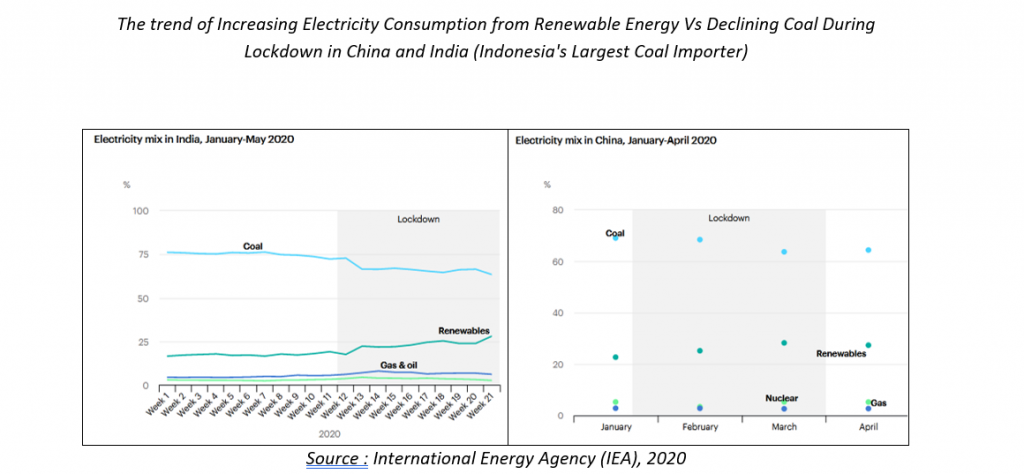
Source : International Energy Agency (IEA), 2020
The reduction of coal demand is indeed happening in almost all countries. In addition, the increasing global market competition since many coal exporter countries to Europe forced to increase their target markets in Asian. This is happened to Russia which is the biggest coal exporter to Europe due to declining European demand trends. While other coal exporting countries to Europe such as the United States experienced a reduction in exports by 11 million tons and Columbia experienced export constraints due to the access blockade during Covid-19.[2] This proves that besides coal is not environmentally friendly fuel, it is also vulnerable to the crisis situation like Covid-19 compared to renewable energy.
However, some decisions of the Ministry of Energy and Mineral Resources even strengthened the portion of coal in the national energy mix by increasing its production targets each year. In 2020, the government plans to produce coal to 550 million tons, which is higher than in 2019, which amounted to 489.10 million tons. Of this total, around 395 million tons are planned for export. But until July 2020, the realization only reached 146.50 Million Tons (37.09%) which is still far from the target. Meanwhile the allocation for the Domestic Market Obligation (DMO) which meet 92.23 million tons (59.51%) until July 2020 from the planned 155 million tons. To force the coal absorption, the government is trying to optimize domestic marketing and looking for new opportunities in the global market. But this action potentially reduce the focus of the government to reach development of renewable energy.
This is increasingly proven due to the reduction of the Ministry of Energy and Mineral Resources’s budget to develop renewable energy. This was announced at June 25, 2020. The government has categorized Covid-19 as national disaster so funds are allocated to tackle the Covid-19. Fund for renewable energy development and conservation has been cut down IDR 562,8 billion (38 million USD), which was originally planned to reach IDR1.173 trillion (80 million USD).[3]
As coal mining located in forest area, such as PT. Triaryani and PT. Musi Mitra Jaya mining area sending a threat for Hutan Harapan ecosystem restoration area in Jambi, and healthy tropical forest ecosystem is important to avoid spill over pathogen to human habitat, maintain and increasing support for safe renewable energy should be part of effort to tackle covid19 pandemic.
[1] https://www.esdm.go.id/id/booklet/capaian-kinerja-2019-dan-program-2020
[2] https://www.argusmedia.com/en/news/2099068-eu-coal-demand-to-fall-as-imports-reach-30year-low
[3] https://www.esdm.go.id/id/media-center/arsip-berita/-bantu-penanggulangan-covid-19-kementerian-esdm-realokasi-anggaran-rp346-triliun
]]>Press Release, June 3, 2020
Perkumpulan Aksi Ekologi & Emansipasi Rakyat (AEER), Jatam Central Sulawesi, Yayasan Tanah Merdeka
.The cheap prices of processed nickel ore products produced in Indonesia are inseparable from cheap labor costs and incomplete environmental standards from the beginning to the post-mining period. Nickel products produced from Indonesia in the form of hot rolled stainless steel sheets and coils (SSHR) are cheaper on the international market. This triggers the European Union to impose anti-dumping fees on nickel products from Indonesia.
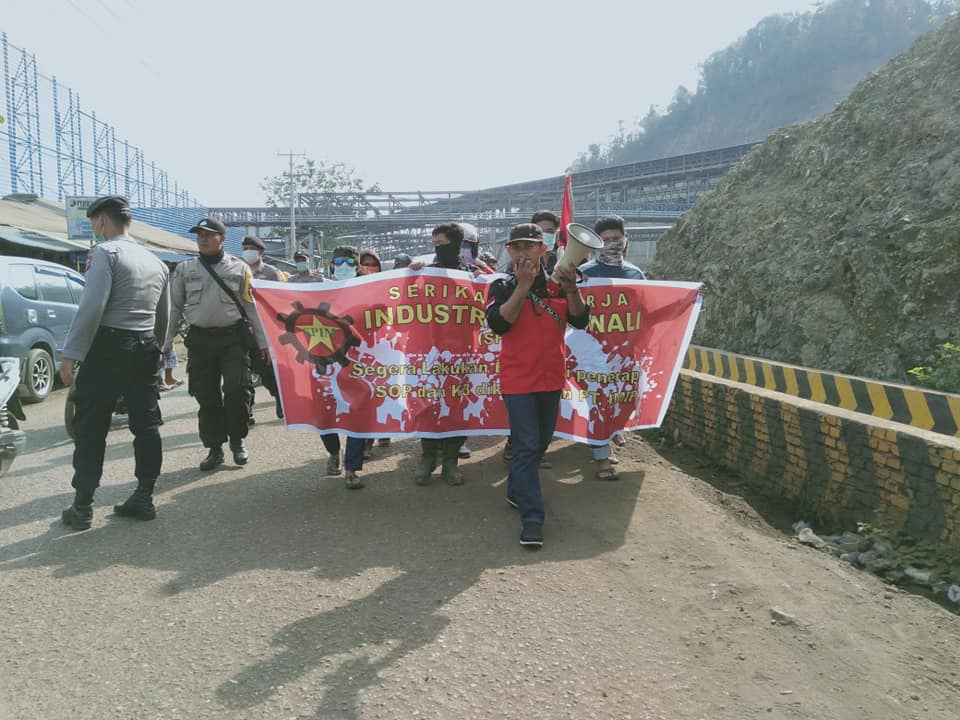
The cheap prices of processed nickel ore products produced in Indonesia are inseparable from cheap labor costs and incomplete environmental standards from the beginning to the post-mining period. Nickel products produced from Indonesia in the form of hot rolled stainless steel sheets and coils (SSHR) are cheaper on the international market. This triggers the European Union to impose anti-dumping fees on nickel products from Indonesia.
The European Union is examining the possibility of dumping two nickel products from Indonesia. That is PT Indonesia Tsingshan Stainless Steel, Jakarta (‘ITSS’), PT Indonesia Guang Ching Nickel and Stainless Steel Industry, Jakarta (‘GCNS’).
PT. CGNS has a production capacity of 600,000 per year, buying semi-finished nickel products from supplier companies located at PT IMIP, consuming 6 million tons of nickel ore at 1,9%. The fuel needed for drying and burning nickel ore is coal powder, with a quantity of lignite of 480,000 tons per year.
PT Indonesia Tsingshan Stainless Steel (ITSS) with a stainless steel production capacity of 1 million tons per year and 1 rolling production line with a production capacity of 2 million tons per year, buys supplies from companies located at IMIP.
In the decision of the European Union Commission on 7 April 2020, applying an anti-dumping levy of 17% for the two companies products is valid for the next six months for several types (HS code).
Based on Foreign
Trade Statistics of Central Sulawesi Province in 2018, there are 4 types of
nickel products with the same HS code subject to anti-dumping fees.
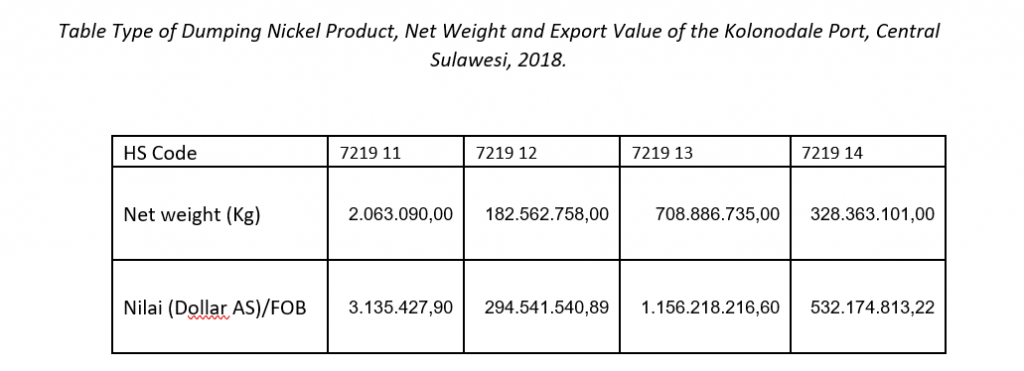
If production remains the same as in 2018, with an estimated 3% export to the European market from the Port of Kolonodale, Central Sulawesi, then the total levied from anti-dumping costs in 6 months is USD 5.064.478,50 or equal to IDR 73.434.938.198,60 (with an exchange rate of 1 USD = IDR 14,500).
This amount is very large compared to some types of expenditure of the Central Sulawesi Provincial Government. For example Capital Expenditures for Equipment and Machines – Procurement of Teaching Aids / School Practices in 2019 amounting to IDR 64.475.000.000,00, or Capital Expenditures for Buildings – Procurement of Health Buildings in the amount of IDR 32.007.311.133,00. The cost of dumping is equivalent to raising the annual salary of 10.000 workers in Morowali by 17%.

The consequences of anti-dumping certainly have added value which is not enjoyed by laborers, citizens around the mining and local environmental protection and rehabilitation. Workers complain about the long working hours even in the midst of a pandemic.
The target of low export prices is unsustainable, detrimental to the environment, labor, and affected citizens.
The imposition of anti-dumping costs is related to the protection of the industry of the market countries, but this is inseparable from the policy of the nickel industry which suppresses the lowest costs.
This anti-dumping can be avoided by increasing labor costs which will improve the overall local people’s economy, post-mining environmental management, the application of best air pollution technology so that citizen complaints in the form of dust from the nickel industry coal power plant does not occur (will ultimately reduce the health of citizens).
The government is also expected to not implement the disposal of nickel processing waste into the sea for low cost, because cheap nickel products only sacrifice the surrounding residents, laborers, terrestrial and marine biodiversity.
]]>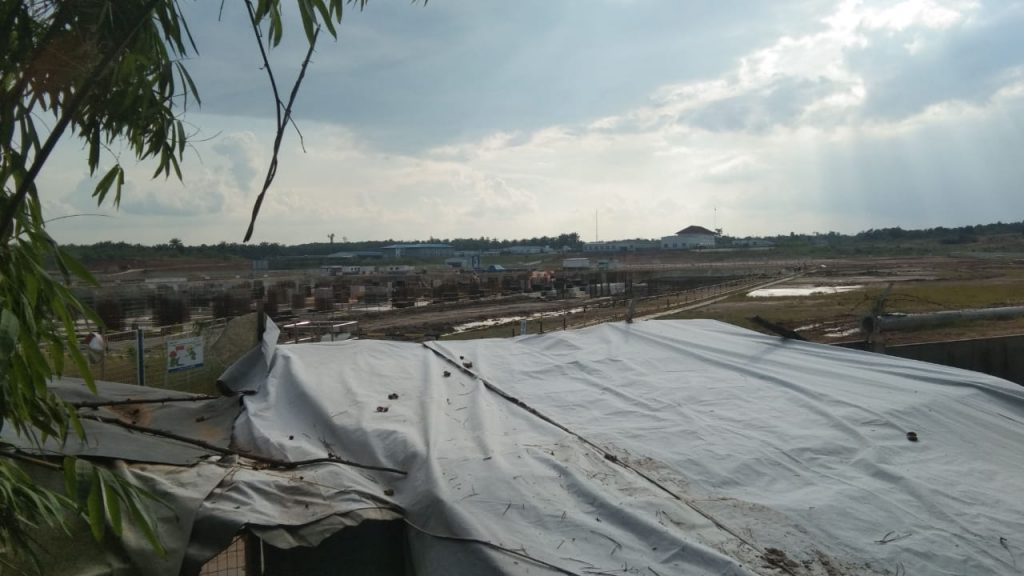
Sumsel 1 coal power plant in Muara Enim (owned majority by Shenhua Gou Hua. Fomerly this site was community plantation, and community plantation nearby site is inundated because the run of water blocked by this site. Picture taken 28 February 2020
On April 29, 2020, over 260 civil society groups across the world called on the Chinese government to ensure that COVID-19 related financial relief for struggling Belt and Road projects flows only to high quality overseas investments satisfying specific stringent criteria, and avoid bailing out projects already mired in environmental, social, biodiversity, climate, or financial risks prior to the onset of COVID-19.
In February 2020, China’s Ministry of Commerce and the China Development Bank (CDB) jointly issued a notice creating a mechanism for directing finance to Belt and Road projects that have been impacted by the COVID-19 pandemic. The announcement instructed local commerce departments and centrally state-owned enterprises to collect information on overseas projects impacted by the outbreak, and pass this information on to CDB, which will consider providing financial relief to get projects back on track. Crucially, the notice states that projects that are “high quality”, “legally compliant”, and have “controllable risks” can qualify to receive COVID-19 related financial relief.[1]
In the statement, civil society groups highlighted 60 Chinese sponsored projects in the mining, pulp and paper, hydropower, infrastructure, fossil fuel, and other sectors which do not meet these criteria, and set out ten specific principles that if present could help to ensure that projects are “high quality”. This includes ensuring credible, robust environmental impact assessments, obtaining free, prior informed consent from affected people, committing not to impact on key biodiversity areas, and ensuring alignment with international norms and best practices and China’s green finance policies, among others.
As the world continues to respond to the COVID-19 crisis, economies are contracting, unemployment rising, and major development projects are stalled. As we find ways to manage the crisis and begin to address the harm caused by the pandemic, Chinese and global development actors will need to seriously consider how low quality, high risk investments may not only drive negative environmental, social, climate, and biodiversity impacts, but may also facilitate the spread of diseases, as a consequence of encroachment on undisturbed ecosystems.
In a
post COVID-19 world, global actors will need to take stronger, decisive steps to
stabilize and revitalize the global economy in an ecologically safe, people-oriented,
and sustainable manner, and ensure that any COVID-19 related financial relief is
allocated to projects and investments which are fully supported by and benefit
local communities, align with international standards and best practice, and preserve
our world’s increasingly fragile ecosystems.
[1] Ministry of Commerce & China Development Bank (2020) #61, Work Notice On Supporting the High Quality and Cooperative Building of “One Belt One Road” By Unleashing the Role of Development Finance in Response to the COVID-19 Outbreak / 商合函【2020】61号 《关于应对新冠肺炎疫情 发挥开发性金融作用支持高质量共建“一带一路”的工作通知》
]]>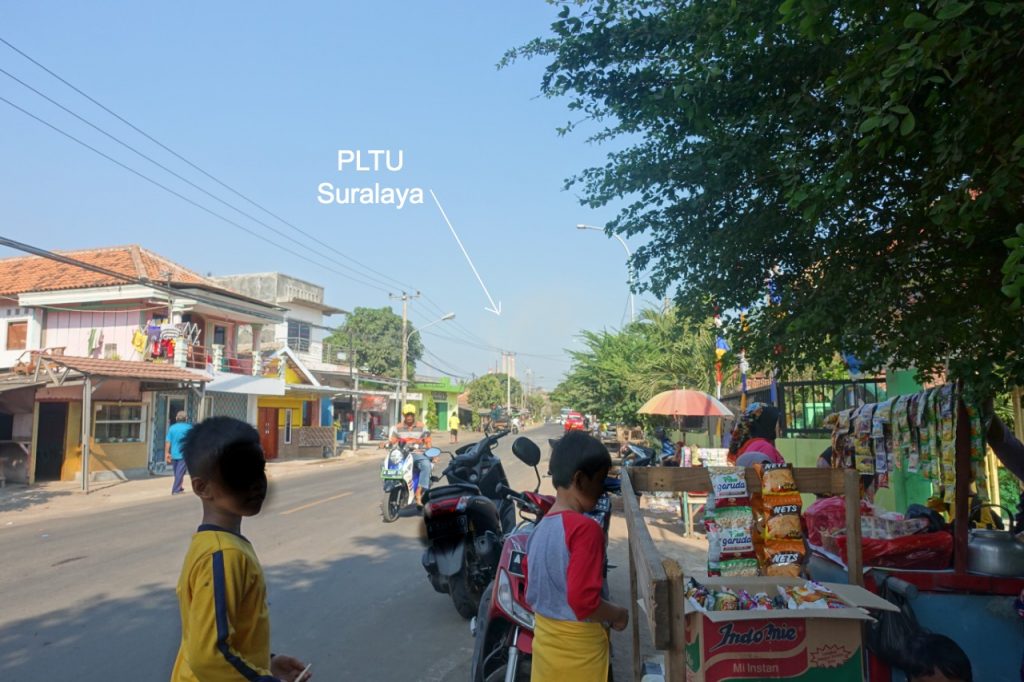
President Jokowi in his speech stated that the second term priority of his administration was the development of human resources champion. The President stated that the quality of human resources starts from the womb, so there should not be any more stunted births. Mother and child health is key, especially until the age of 7-8 years, which is the golden age.
However, the development of quality human resources will not be fulfilled if the residential area filled by pollution. North Banten is filled with a lot of pollution, especially along the lines of Merak, Suralaya, Salira, Pulo Ampel, Bojonegara and Kramatwatu.
In this route there are Suralaya Coal Fired Power Plants with 5 active chimneys releasing air pollution. These power plants provide electricity for Jakarta city and surrounding areas. But the air pollution effects are spreading to the surrounding area. Another coal-fired power plant that has been operating are the Salira power plant and the Merak Energi power plant. Meanwhile, the Java 7 Power Plant (2 × 991 MW) will be operating in October 2019. This is referred as the inauguration gift of President Joko Widodo for the second period by medias
Rows of power plants and the chemical industry on the the road side, land and stone mining activities in the surrounding mountains make poorer ambient air quality. The leaves of the trees along the road were covered in dust, so the remaining campaigns posters of the politicians were also covered with dust.
A number of kindergartens and elementary schools exist in this area. From the Salira Elementary School, the dirty air coming out of the Suralaya power plant’s chimney is clearly visible. The Suralaya-Salira-Terate route is passed by parents to take and pick up their children from school using motorcycle causing air pollution exposure very worrying . A health worker in this area when talking with staff of the AEER Assosiation (Ecological Action and People Emancipation) said he bought a car because he uses it to take his child to school every day to avoid severe air pollution, not for raising prestige and social status reasons.
This dirty air contains fine particles PM 2.5, SOx, NOx which are harmful to the lungs and heart, especially children and the elderly. Another pollution ingredient is mercury which causes interference to the development of children’s brain tissue thereby reducing the ability to concentrate and learn.
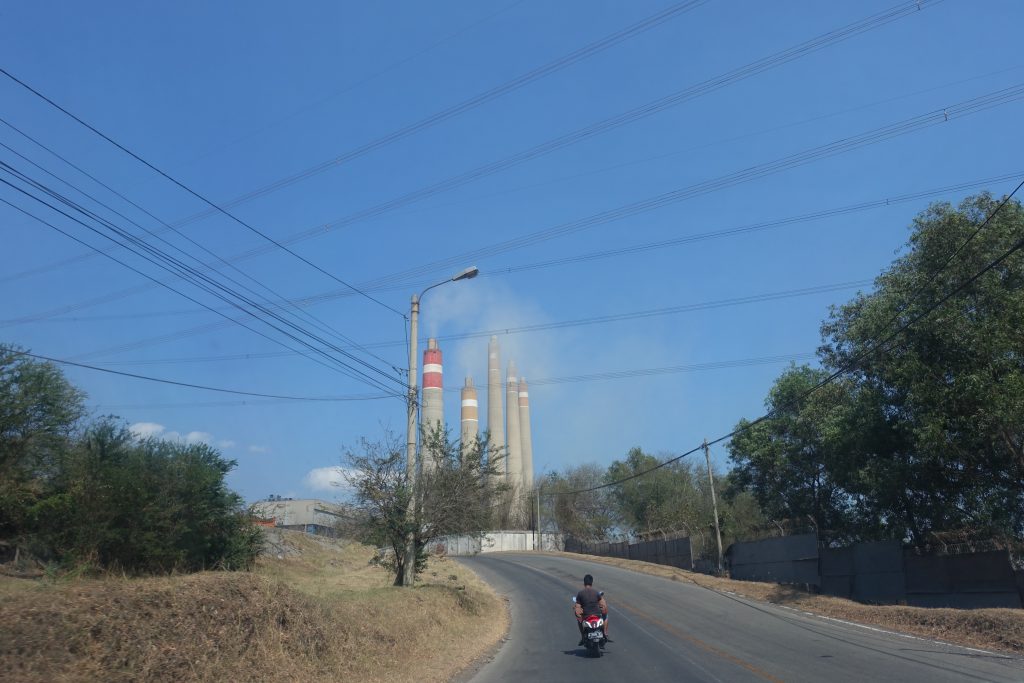
The World Health Organization (WHO) states that babies born to mothers who are exposed to air pollution are more likely to be born prematurely and have low body weight which are the main factors causing stunting.
Severe air pollution in the Suralaya-Salira-Terate Line as the location of a large power plant supply to Jakarta can be mitigated by phasing out power plants with poor pollution control, such as Suralaya; the application of pollution control using international standards – can refer to tighter Chinese pollution control standards for Java Power Plant 7 (majority owned by Shenhua Gouhua); and stopping the addition of coal-fired power plants in this route (planned expansion of the Suralaya power plant, Salira, Terate).
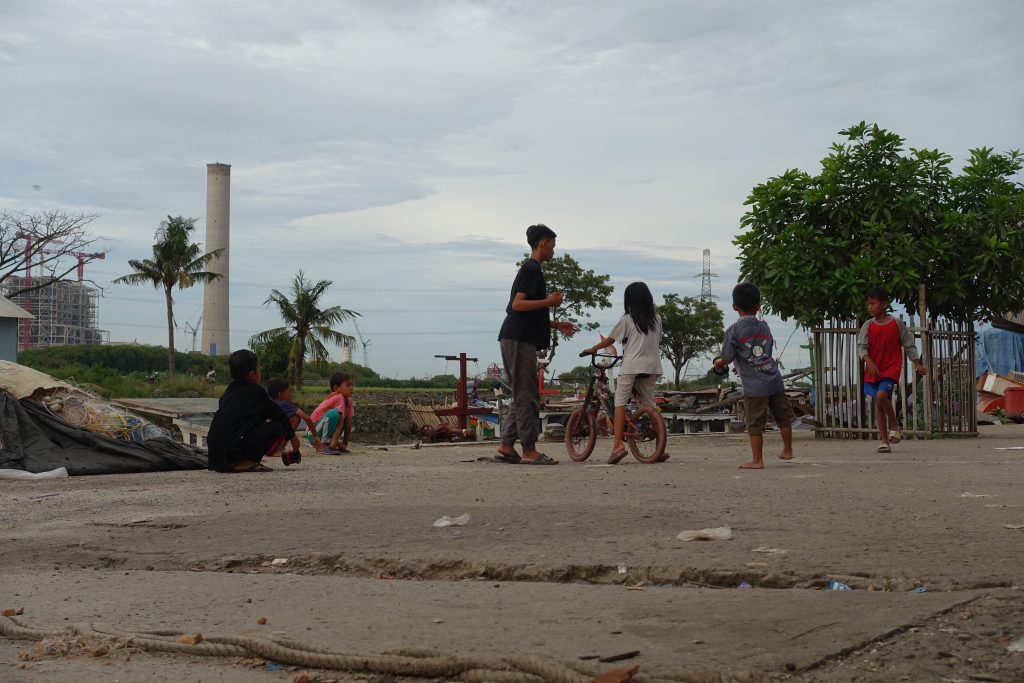
In addition, mining activities and material trucking traffic need to be restricted along this route so that villages and schools along this path are not exposed to air pollution. The Jokowi’s commitment to develop superior human resources is tested in Suralaya, Terate, Salira lanes so that children in this area are not sacrificed for the sake of fulfilling electricity and other products for the Jakarta and surrounding areas
]]>
(Children playing with a background in the Java 7 coal-fired power plant—owned majority by Shenhua Gouhoa under construction which is scheduled to operate in October 2019. The power plant is considered to strengthen the reliability of the Java-Bali transmission network, especially in its west area)
The government and PLN need to improve the reliability of the Java-Bali electricity system by increasing the availability of renewable energy. In the case of a electrical disruption which resulted in a electricity blackout on August 4, 2019, coal-fired power plant seemed incompetent to respond quickly, so it took 6-8 hours to operate normally after being disconnected from the network system.
Regrettably, the PLN and the government’s response to the power outage is to strengthen the Power Plant including promoting the Java 7 Power Plant with a capacity of 2 x 991 MW which is scheduled to operate in October 2019 as a sollution to anticipate the same case. This solution does not consider justice aspect for the people around the Power Plant who receive negative impacts such as health problems due to poor air quality from the Power Plant. In addition there are also fishermen whose fishing space in the sea has narrowed because it has turned into a special location for coal ports and the location of the Java 7 Power Plant. Moreover, the dominance of coal plants make a slow response to power outages because power plants require a long time to be able resuming normal operation.
Another long-term solution offered is to continue the construction of Java HVDC (High Voltage DC) transmission. The consequence of this network is the addition of the Mine-mouth coal-fired power plant in South Sumatra. Mine-mouth coal-fired power plants effect environmental degradation for residents at the power plant site, because they have environmental impacts from mining activities (floods, river diversion, mine dust) and at the same time there is also the impact of power plants (air pollution, noise). The mine-mouth coal-fired power plant caused disturbance to the residents’ agricultural land and rubber plantations in Muara Enim.


Ecological injustice for the Java-Bali electricity fulfillment by sacrificing of environmental quality and the health of residents around the mine-mouth coal-fired power plant must be avoided, in addition, the construction of the Sumatra- Java HVDC which is dominated by the power plant increases greenhouse gases.
The reliability of the Java-Bali electricity system will increase if the renewable energy supply in each region/province is developed. The integration of the Java-Bali system makes fluctuations in the availability of renewable energy manageable, for example if the wind power supply on the South coast of Java slows down, it can be overcome by optimizing land and floating solar power plants that are built in each province. In addition, each province/region can have energy independence and electricity power responses quickly in anticipation of transmission failures between provinces. With the availability of large-scale electricity storage technology, the development of renewable energy is increasingly possible on a large scale and household scale.
]]>
One of the initiatives promised by Chinese President Xi Jinping at the forum Belt and Road Initiative is the implementation of the South-South Cooperation Initiative Belt and Road on Climate Change. The implementation of this initiative in the form of an the form of developing renewable energy and low-emission greenhouse programs is highly expected and urgent. In the second week of May 2019, which is two weeks after the Belt and Road Forum, a sensor at the Hawaii observatory that measured the concentration of atmospheric carbon dioxide (CO2) recorded for the first time in 3 million years the concentration of C02 reached 415.26 ppm. The safe limit for the earth’s climate is 300 ppm. Coal combustion is one source of C02 emissions.
Among the 23 collaborative projects that Indonesia-China has agreed in the Belt and Road Initiative (BRI) Forum, there are three coal-fired power plant (PLTU) projects, namely the Sulbagut-1 and Sulut-3 (cooperation between the PowerChina International Group and PT. Toba Bara Sejahtera), and a coal-fired power plant 2 x 300 MW (cooperation between Indonesia Lumbung Group Co. and Engineering Department of China National Electric (CNEEC)).
The signing of the development of coal-based projects will make it difficult for Indonesia to reduce 29 percent greenhouse gas emissions by 2030.
Toba Bara Sejahtera is in the process of obtaining funding from PT. Sarana Multi Infrastruktur (SMI) for the construction of the PLTU Sulut-3. PT. Sarana Multi Infrastruktur (SMI) is an accredited institution to obtain climate change mitigation funding from the Green Climate Fund, a funding agency for reducing global warming under the UN emissions. During a 25-year operating period, this coal-fired power plant is expected to release 22.5 million CO2.
The third project, namely the PLTU 2 x 300 MW in cooperation between CNEEC and Indonesia Lumbung Group Co is likely to be built in Jambi Province. The construction of coal-fired power plants in Jambi Province is not the right choice. Jambi Province has renewable energy sources, including water. According to the Electricity Supply Business Plan (RUPLT) 2019-2028, the potential of hydroelectric power plants in Jambi Province is 373 MW, while the potential for large-scale hydropower reaches 611.7 MW. Besides the impact of global warming, the number of coal transportation traffic accidents is quite large in Jambi Province.
The PLTU construction project in Indonesia involving PowerChina and CNEEC has caused problems. PowerChina is the majority shareholder (70%) of the PLTU Bengkulu doing injustice for compensation for growing crops when land acquisition. Meanwhile, CNEEC as a contractor for PLTU Indramayu, PLTU Tanjung Awar-awar, PLTU Sumsel-5 and PLTU Banjarsari is also free from the problem.
In 2011, the PLTU Indramayu I with a capacity of 3 x 330 MW officially operated, residents complained about the impact of air pollution.
Considering the urgency to reduce the sources of global warming, the Chinese and Indonesian governments should cancel the coal-fired power plant construction project agreed upon in the Belt and Road Initiative Forum. ***
]]>
Press Release 2 April 2019
The Indonesian government is preparing an investment agenda for the Belt Road Initiative meeting which will take place at the end of April 2019 in Beijing. There are four coal-fired power plant (PLTU) projects offered for investment, namely the Celukan Bawang Expansion (2 x 350 MW) in Bali, the Kalselteng mine-mouth coal-fired power plant 3 (2 x 100 MW) in Central Kalimatan, the Kalselteng mine-mouth coal-fired power plant 4 (2 x 100 MW) in Central Kalimatan, and 1,000 MW PLTU in North Kalimantan. A coal generating unit aged 20 to 30 years. This means that the construction of coal plants a locking-in investment, closing the space for developing renewable energy in a long time.
Mardan Pius Ginting, Coordinator of the AEER (Action for Ecology and Emancipation of the People) said that the locations of the PLTU that are to be offered into BRI have problems. The exisiting Celukan Bawang has experiencing opposition from fishermen and has received international attention because it is located on the island of Bali which is the main tourism area where visitors are looking for a place that has clean air. Even the Governor of Bali has urged the termination of the use of coal for the Celukan Bawang power plant which has been operating.
Central Kalimantan, one of the provinces experiencing the widest deforestation due to the development of mining and plantations. Recorded in 2016 deforestation occurred in the area of 44,726.3 are. By developing mine-mouth coal-fired power plants, the area so far relatively isolated from investment will be opened to become a mining area to supply coal for the mine-mouth coal-fired power plants. Based on the RUPTL (Electricity Supply Business Plan), Central Kalimantan has renewable energy sources, including water. It is better to develop hydropower with limited capacity that needs to be developed in line with forest conservation.
North Kalimantan itself has plans for construction of hydroelectric power. Construction of a coalpower plant in North Kalimantan will expand deforestation for its coal supply.
Financing of this coal-fired power plant inhibits the development of renewable energy.
The price of wind and solar power technology continues to decrease, but its application into the electricity system has been hampered because the government wants to protect the electricity market from coal power plant sources. This is reflected in the obstacles made by the government for the installation of solar electricity in Jakarta, including by only valuing 65% of each unit of electricity produced from solar power. This is a form of disincentive for the development of renewable energy.
Coal-fired power plant has created environmental damage, health and exacerbated global warming. The world is working on a transition to leaving the Coal Power Plant. Protests against the continuing use of fossil fuels occur in many countries, and even school children participate in large mobilizations against the use of fossil fuels which are a source of greenhouse gases.
The Indonesian government should not conflict with global flows that want to get out of using of coal fuel. By fighting this flow, the damage is actually experienced by the people of Indonesia. Environmental damage in the coal mining area continues, air pollution from the plant adds to the number of sick people while the health budget through BPJS is increasingly felt to be a burden by the government, destruction of fishing grounds due to liquid waste disposal and massive coal barge traffic at the site PLTU (coal power plant).
In order to be in line with the global flow that requires immediate action to overcome global warming, the Indonesian Government was asked not to include coal-fired power plants in the Belt Road Initiative negotiations.
]]>
For the last eight years (2011-2018), companies from Japan and China companies have commercialized electricity with a capacity of 3,956 MW, consists of 2,805 MW own by Japan electricity, while China own 1,151 MW. Meanwhile, in the same period, the operating coal-fired power plant wholly owned by PLN is 8,836 MW.

Source: Processed from sourcewatch.org; Electricity Supply Business Plan 2018-2027; and various other sources.
In addition to those that have been commercially operated, there are also joint venture companies involving Japan and China still under-construction throughout the archipelago.
Some of the coal-fired power plant technologies from Chinese and Japanese investments utilize ultra-super critical boilers, which is claimed to be clean technology. Nevertheless, the amount of greenhouse gas emissions produced is still high, at least 195 times the Republic of Vanuatu, a threatened country by sea level rise due to climate change.
The involvement of Japan and China in the joint venture illustrates that the energy sector, especially coal-based power plants, are important for source of profit. A survey on energy actors in Indonesia conducted by the PWC in 2018, reported that the energy industry investment players, including fossil energy in Indonesia, expected the equity return in Indonesia to be 15% – 20%, this figure is higher than global equity returns, 10.6%.
China and Japan are listed as the largest sources of public founding for overseas coal plants (Global Coal Finance Tracker, December 2018). Companies or financial institutions from these two countries have been deeply involved in procuring overseas coal plants, including Indonesia. For example, the Java-7 coal-fired power plant. This power plant has a capacity of 2x 991 MW and will be commercial in 2020. It is owned by Shenhua Group (70%) and PT Pembangkitan Jawa-Bali (30%), a subsidiary of PLN. In 2017, a fund of 1.8 billion US dollars was disbursed by the China Development Bank.
In the past eight years, Japan and China have commercialized electricity with a capacity of almost four gigawatt. For some few years ahead, the involvement of Japan and China in the fossil energy coal sector will increase. However, the consequential damaging effects have to be taken into account. Environmental damage, health problems, and the loss of people’s access to the economy due to the negatively affected livelihood areas cannot be avoided if the coal-fired power plant continues to develop, and impedes Indonesia ‘s route to low carbon economy.
]]>The Indonesian government, through PLN (the State-owned electricity company/ PT Perusahaan Listrik Negara) in Electricity Supply Business Plan/RUPTL), also announced that it’s using clean coal technology to reduce emissions. For the Java-Bali power system, PLN has allocated a class capacity 1,000 MW coal-fired power plant with USC as part of clean coal technology to obtain better efficiency and lower CO2 emissions. One of them are Java-7 (2 × 919 MW) owned by a joint venture by Shenhua Guohua and PT. Pembangkit Jawa Bali (PJB).

The second grid national system in Sumatra island also began the development of coal-fired power plant utilizing USC with a class capacity of 300-600 MW with USC.
List of ultra super critical technology coal-fired power plant of Chinese and Japanese’s investment in Indonesia
Coal Power Plant |
Capacity (MW) |
Owner |
| Tanjung Jati B Unit 5 | 1,000 | Sumitomo |
| Tanjung Jati B Unit 6 | 1,000 | Sumitomo |
| Java-7 Unit 1 | 991 | National Energy Investment Group (Shenhua Guohua) 70%, PT PJB 30% |
| Java-7 Unit 2 | 991 | National Energy Investment Group (Shenhua Guohua) 70%, PT PJB 30% |
| Central Java (Batang) Unit 1 | 950 | Adaro, Itochu-J Power |
| Central Java (Batang) Unit 2 | 950 | Adaro, Itochu-J Power |
In total, 5,882 MW Ultra Super Critical related to Japanese and Chinese investments in Indonesia currently. With the carbon dioxide intensity factor 740–800 g CO2/kWh for USC technology, the total capacity of this plant will produce 26-28 million tons of carbon dioxide per year. This is equivalent to 148 to 195 times the carbon dioxide gas emissions of the Republic of Vanuatu in 2016, one of the island countries in the Pacific Ocean that is most threatened by sea level rise due to global warming.
Contradicted to the claim that has been put in PLN’s Electricity Supply Business Plan, The Energy Sector Greenhouse Gas Emission Inventory Data which issued by the Ministry of Energy and Mineral Resources 2016 stated “based on historical data on GHG emission reduction in the power generation sector, the use of CCT does not contribute much to emission reduction, only 15% of total emissions issued of the power generation sector or 4% of the total reduction in energy sector GHG emissions.” This report suggested cogeneration electricity, that can reach 85% total emission reduction in the power generation sector, or 20% of the total reduction in GHG emissions in the energy sector. ”
Besides greenhouse gas emissions, the construction of electricity generation mainly in the coastal area has caused damage and disruption to the ecology of the coastal area where fishermen community live. Such as in coastal area of Terate, Serang Regency, Banten Province, communities has experienced a decline in fishing space due to the coastal has been reclaimed for the construction of Java 7 coal power plant.
Ultra Super Critical technology is still emitting too high greenhouse gases, making it difficult for Indonesia to reach of its reducing greenhouse gases target from the energy sector. As a country whose technology has advanced, China and Japan should concretize their leadership in overcoming climate change by stopping the development and promotion of USC coal-fired power plant. And they should use their overseas investment capacity to develop renewable energy, including in Indonesia.
]]>China adalah negara yang paling besar melakukan investasi energi terbarukan untuk dalam negeri, sebesar 102,9 milyar $AS pada tahun 2015, sementara itu Amerika Serikat jauh lebih kecil yakni sebanya 44,1 milyar $AS (Laporan Institute for Energy Economics and Financial Analysis, IEEFA, 2017). Hal ini tentu diapresiasi.
China is the largest investment in renewable energy in each its domestic country, amounting to US $ 102.9 billion in 2015, while the United States is much smaller at US $ 44.1 billion (Report of the Institute for Energy Economics and Financial Analysis, IEEFA, 2017). This is certainly appreciated.
China is expected to take more action to tackle climate change. Investment from China is currently listed as one of the largest in the coal energy sector. Among them are Java 7, South Sumatra, Celukan Bawang coal-fired power plant in the form of ownership with a total capacity of 3,666 MW, which will consume 12.8 million tons of coal per year, which will produce more than 12 million tons of carbon dioxide per year.
The existence of coal power plant investments from China has begun in the Susilo Bambang Yudhoyono’s Government through the Fast Track Program I (FTP I) of 10,000 MW and FTP II of 17,918 MW and 35,000 MW programs during the current Jokowi’s administration.
In China itself, the coal-fired power plant has been reduced. Recorded in China as many as 150 coal power plants have been suspended to achieve the target of reducing greenhouse gases emissions and overcoming pollution.
The Chinese government, as well as other countries such as Japan, argue that they are still supporting coal abroad because their partner countries are still developing coal-fired power plants. This is certainly contrary to the spirit of foreign investment policies made by China.
The Green Credit Guidelines issued by the Bank of China Regulatory Commission in 2007 directed foreign projects supported by funding from China in line with international good practice. Several international financial institutions have stopped funding coal, this development is a good standard of practice amid the urgent actions to reduce greenhouse gas emissions.
The Chinese government needs to show its leadership globally in stifling the pace of climate change by reconsidering (withdrawing or canceling) its investments from fossil energy projects.
In the time global trend to leave coal, Indonesia is increasingly consumptive in this type of energy. Various rejections have come from residents and local and international organizations because they are vulnerable to ecology and social relations, but the construction of the power plant continues in a number of regions. The rate of power plant construction is higher than other energy, and until 2017 coal dominates the national energy supply, which is 57.22% (LAKIN DJK 2017). Meanwhile, renewable energy moves slowly and shows signs of heavy homework to reach the target of 20% in 2025.
The Minister of Indonesian National Development Planning, Bambang Brodjonegoro, at the 24th Climate Change Summit in Katowice, Poland, said the three aspects that the Indonesian government sought to mitigate climate change were the use of renewable energy, forest rejuvenation and more efficient transportation. In the energy sector, the report compiled by Germanwatch, the New Climate Institute and Climate Action, 2018, shows Indonesia’s performance is relatively low (from four categories: high, medium, low and very low) for renewable energy. The report said, the lack of an effective mechanism was one of the factors supporting the slowdown in the development of renewable energy.
The old style development paradigm that upholds economic growth but despite ecological sustainability is naturally overhauled. The refusal of citizens and a number of environmental organizations should be noted as consideration by business people and decision makers. For a long time the Indonesian people became victims of operating fossil fuel-based power plants that disturbed their social and ecological “peace”. This injustice in the supply of energy which sacrifices residents around the plant needs to be stopped by switching to renewable energy.
]]>